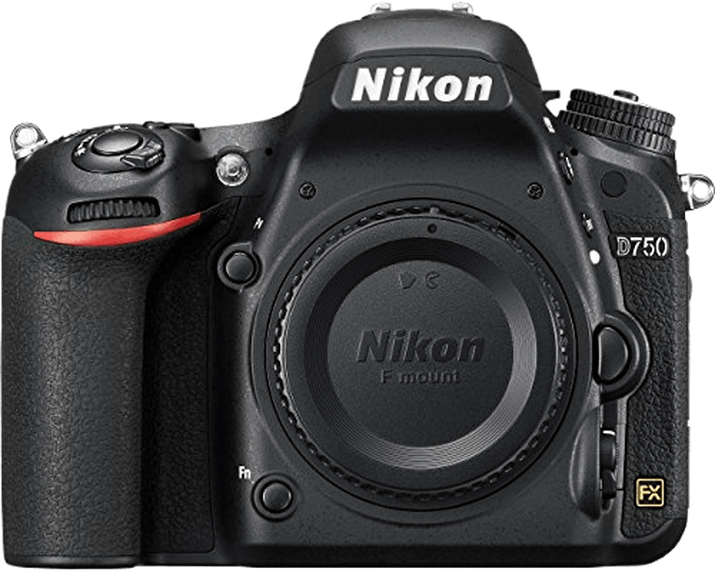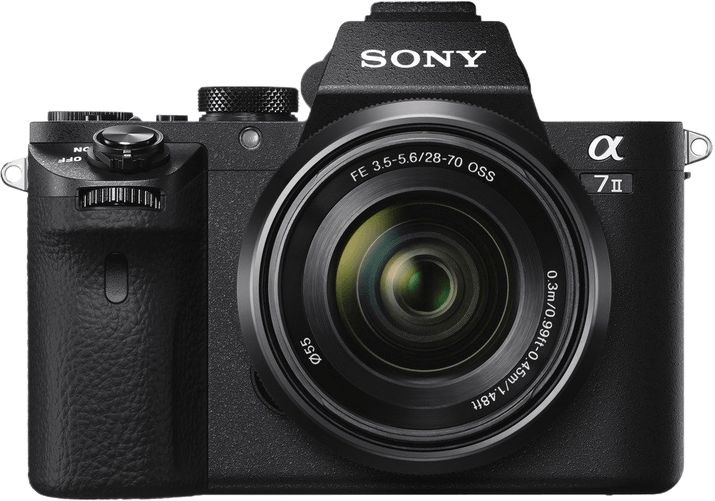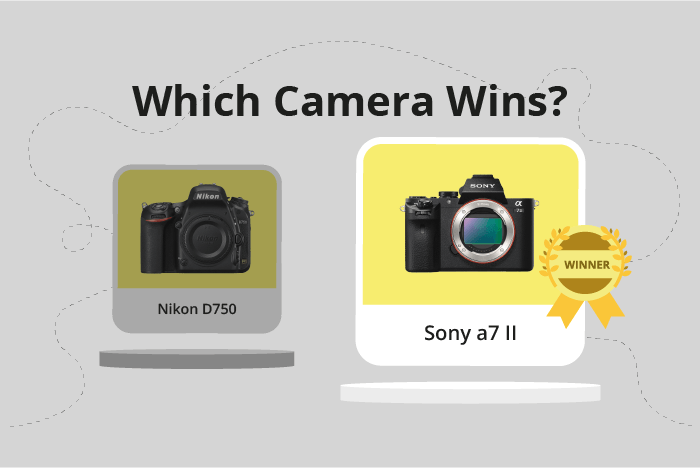Nikon D750 vs Sony a7 II Comparison
Nikon D750

Sony a7 II

The Nikon D750 and Sony a7 II both score a 69 out of 100, showing their similarities in performance. These cameras share the same announcement year, 2014, and have comparable general specifications. However, the Nikon D750 is a DSLR, while the Sony a7 II is a mirrorless camera.
The Nikon D750 has a larger body, measuring 141 x 113 x 78mm, and weighs 750g, making it more substantial than the Sony a7 II, which measures 127 x 96 x 60mm and weighs 599g. This extra weight and size can be an advantage for those who prefer a more robust camera.
On the other hand, the Sony a7 II, being a smaller and lighter camera, is more portable and convenient for travel or on-the-go photography. Additionally, the Sony a7 II has a lower launch price of $1600, compared to the Nikon D750’s $2300, making it more budget-friendly.
Both cameras have their pros and cons, with the Nikon D750 being more suitable for those who prefer a sturdier build, while the Sony a7 II is ideal for those seeking portability and a lower price point.
Nikon D750 vs Sony a7 II Overview and Optics
The Sony a7 II wins in the optics comparison with a score of 78/100, while the Nikon D750 scores 71/100. Both cameras share some common specifications, such as 24-megapixel full-frame CMOS sensors, which provide excellent image quality. They also have different lens mounts, with the Nikon D750 using the Nikon F FX mount and the Sony a7 II using the Sony E mount.
The Sony a7 II outperforms the Nikon D750 in some aspects. One significant advantage is its built-in image stabilization, which helps reduce camera shake and improve image sharpness, especially in low light situations. The Sony a7 II also has a more advanced processor, the Bionz X, which contributes to faster image processing and better noise reduction at high ISOs.
On the other hand, the Nikon D750 has a higher DXOMARK score for its sensor (93) compared to the Sony a7 II (90), indicating better overall image quality. The Nikon D750 also has a faster shooting speed of 6.5 frames per second, compared to the Sony a7 II’s 5 frames per second, which can be beneficial for capturing fast-moving subjects.
Based on these comparisons, the Sony a7 II offers superior image stabilization and a more advanced processor, making it a better choice for those who prioritize image sharpness and low light performance. However, the Nikon D750 provides better overall image quality and faster shooting speed, making it more suitable for action photography. Ultimately, the choice between these two cameras depends on the specific needs and preferences of the photographer.
Nikon D750 vs Sony a7 II Video Performance
The Nikon D750 and Sony a7 II share an equal video score of 56/100, making it a tie in this aspect. Both cameras have several common video specifications, which contribute to their identical scores. These shared features include a maximum video resolution of Full HD, video dimensions of 1920 x 1080, and a maximum video frame rate of 60fps. Additionally, neither camera has built-in time-lapse functionality.
Examining the video capabilities of the Nikon D750, it is difficult to pinpoint specific advantages over the Sony a7 II due to their equal scores and shared specs. However, the D750 is known for its excellent low light performance and accurate color reproduction, which can be beneficial for videographers shooting in various lighting conditions.
On the other hand, the Sony a7 II also does not have any apparent advantages over the Nikon D750 in terms of video capabilities. Its video performance is on par with the D750, providing users with similar results. The a7 II is recognized for its reliable autofocus system and image stabilization, which can be helpful for video recording, especially when shooting handheld or tracking moving subjects.
Given the identical video scores and similar specifications, both the Nikon D750 and Sony a7 II offer comparable video performance, making it challenging to declare a clear winner in this category. The choice between these two cameras may ultimately come down to personal preference and other factors such as brand loyalty, ergonomics, and additional features not directly related to video capabilities.
Nikon D750 vs Sony a7 II Features and Benefits
The Nikon D750 wins the feature comparison with a score of 59/100, while the Sony a7 II scores 57/100. Both cameras share several specifications, including the absence of a touchscreen, GPS, and Bluetooth. They also both feature a flip screen and WiFi connectivity.
The Nikon D750 stands out with its larger screen size of 3.2 inches compared to the Sony a7 II’s 3-inch screen. This difference may provide a better viewing experience for users when composing and reviewing images. The screen resolution is similar between the two cameras, with the D750 having 1,229,000 dots and the a7 II slightly ahead with 1,230,000 dots. However, this small difference in resolution is unlikely to impact the overall user experience significantly.
The Sony a7 II does not have any notable advantages over the Nikon D750 in terms of features. Both cameras have similar specifications, and the only differences lie in the screen size and resolution, which slightly favor the D750.
Considering the features of both cameras, the Nikon D750 is a better choice due to its larger screen size. The similar specifications between the two cameras make the decision based on features alone challenging. However, the D750’s slightly higher score indicates that it offers a marginally better user experience. On the other hand, the Sony a7 II does not provide any significant advantages in the feature comparison. Therefore, the Nikon D750 emerges as the winner in this comparison.
Nikon D750 vs Sony a7 II Storage and Battery
The Nikon D750 triumphs over the Sony a7 II in storage and battery, with a score of 79/100 compared to 35/100. Both cameras accept SD, SDHC, and SDXC memory cards, but the D750 offers two memory card slots while the a7 II has only one. Additionally, the a7 II supports Memory Stick Duo, Pro Duo, and Pro-HG Duo cards.
The D750’s superiority is evident in its battery life, providing 1230 shots per charge with its EN-EL15 battery. In contrast, the a7 II’s NP-FW50 battery delivers a mere 350 shots.
Despite its lower score, the Sony a7 II does have the advantage of supporting multiple memory card formats. However, the Nikon D750’s longer battery life and dual memory card slots make it the clear winner in this comparison for storage and battery capabilities.
Alternatives to the Nikon D750 and Sony a7 II
Are you still undecided about which camera is right for you? Have a look at these popular comparisons that feature the Nikon D750 or the Sony a7 II:

